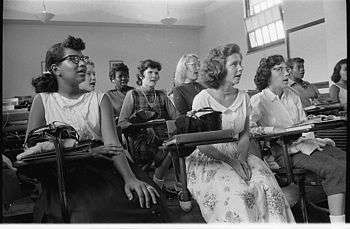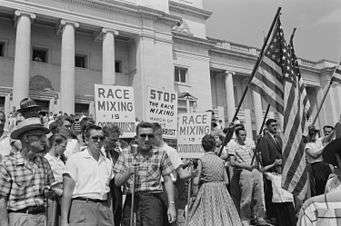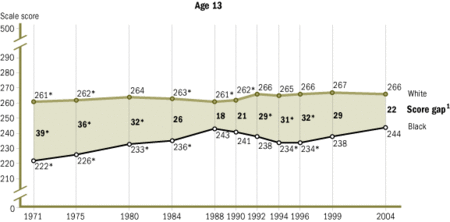School integration in the United States

School integration in the United States is the process of ending race-based segregation, also known as desegregation, within American public and private schools. Racial segregation in schools existed throughout most of American history and remains a relevant issue in discussions about modern education. During the Civil Rights Movement school integration became a watershed event.[1]
Background
Early history of integrated schools
Some schools around America were integrated before the mid-20th century, the first ever school being Lowell High School in Massachusetts, which has accepted students of all races at its inception. The earliest known African American student, Caroline Van Vronker, attended the school in 1843. The integration of all American schools was a major catalyst for the civil rights action and racial violence that occurred in the United States during the latter half of the 20th century.
After the Civil War, the first legislation providing rights to African-Americans was passed. The 13th, 14th, and 15th Amendments, also known as the Reconstruction Amendments, which were passed between 1865 and 1870, abolished slavery, guaranteed citizenship and protection under the law, and prohibited racial discrimination in voting, respectively.[2]
Jim Crow south
Despite these Reconstruction amendments, blatant discrimination took place through what would come to be known as Jim Crow laws. As a result of these laws, African-Americans were required to sit on different park benches, use different drinking fountains, and ride in different railroad cars than their white counterparts, among other segregated aspects of life.[3] Though the Civil Rights Act of 1875 prohibited discrimination in public accommodations, in 1896 the Supreme Court ruled in the landmark case Plessy v. Ferguson that racially segregated public facilities such as schools, parks, and public transportation were legally permissible as long as they were equal in quality.[3] This separate but equal doctrine legalized segregation in schools.
Black Schools
This institutionalized discrimination led to the creation of black schools—or segregated schools for children of African-American descent. With the help of philanthropists such as Julius Rosenwald and black leaders such as Booker T. Washington, black schools began to gain repute and became respectable institutions. These schools soon assumed prominent places in black communities, with teachers being seen as highly respected community leaders.[4] However, despite their important role in black communities, black schools remained underfunded and ill equipped, particularly in comparison to white schools. For example, between 1902 and 1918, the General Education Board—a philanthropic organization created to strengthen public schools in the south—gave $2.4 million to black schools and over $25 million to white schools.[4]
Legal action
Throughout the first half of the 20th century there were several efforts to combat school segregation, but few were successful. However, in a unanimous 1954 decision in the Brown v. Board of Education case, the Supreme Court ruled segregation in public schools unconstitutional. The NAACP legal team representing Brown, led by Thurgood Marshall, argued that racially separate schools were inherently unequal, as society as a whole looked down upon African-Americans and racially segregated schools only reinforced this.[5] They supported their argument with research from psycologists and social scientists in order to empirically prove that segregated schools inflicted psychological harm on black students.[6] These expert testimonies, coupled with the concrete knowledge of black schools having worse facilities than white schools and black teachers being paid less than white teachers, contributed to the landmark, unaminous decision.[6]
Initial responses to school integration
Criticism

Despite the federal ruling in Brown v. Board of Education, integration was met with immediate opposition. In 1955, Time magazine reviewed the status of desegregation efforts in the 17 southern and border states, grading them from "A" to "F" as follows: "A"-Missouri; "A-minus"-West Virginia; "B-plus"-Kentucky, Oklahoma; "B-minus"-Maryland; "C-plus"-Arkansas, Texas; "C"-Delaware, Tennessee, "C-minus"-North Carolina; "D-plus"-Virginia; "D"-Florida; "F"- Alabama, Georgia, Louisiana, Mississippi, South Carolina.[7]
A policy of "massive resistance" was declared by Virginia Senator Harry F. Byrd and led to the closing of nine schools in four counties in Virginia between 1958 and 1959.[8] Supporting this policy, a majority of southern congressmen in the U.S. House of Representative signed a document in 1956 called the Southern Manifesto, which disavowed the racial integration of public institutions such as schools.[9] In 1957, in accordance with massive resistance, Governer of Arkansas Orval Faubus called upon the Arkansas National Guard to prevent nine black students from attending the newly segregated Central High School in Little Rock, Arkansas.[10] In response, President Dwight D. Eisenhower dispatched federal troops to safely escort the group of students - soon to be known as the Little Rock Nine - to their classes in the midst of violent protests from an angry mob of white students and civilians.[11]
Praise
Prominent black newspapers such as the Chicago Defender and the Atlanta Daily World praised the Brown decision for upholding racial equality and civil rights.[12] The editors of these newspapers recognized the momentous nature and symbolic importance of the decision.[12] Immediately, Brown v. Board of Education proved to be a catalyst in inciting the push for equal rights in southern communities, just as Charles Houston and Thurgood Marshall had hoped when they devised the legal strategy behind it.[13] Less than a year after the Brown decision, the Montgomery bus boycott began—another important step in the fight for African-American civil rights.[13] Today, Brown v. Board of Education is largely viewed as the starting point of the Civil Rights Movement.[1]
By the 1960s and 70s, the Civil Rights Movement had gained significant support. The Civil Rights Act of 1964 prohibited segregation and discrimination based on race in public facilities, including schools, and the Voting Rights Act of 1965 prohibited racial discrimination in voting affairs. In 1971 the Supreme Court in Swann v. Charlotte-Mecklenburg Board of Education approved the use of busing to achieve desegregation, despite racially segregated neighborhoods and limited radii of school districts. By 1988 school integration reached an all-time high with nearly 45% of black students attending previously all-white schools.[2]
Implementation
Brown II
After Brown vs. Board of Education ruled that school segregation was unconstitutional, the implementation of desegregation was discussed in a follow-up Supreme Court case termed Brown II.[14] Though the NAACP lawyers argued for an immediate timetable of integration, the Supreme Court issued an ambiguous order that school districts should integrate with “all deliberate speed."[12][15]
White Flight
Various options arose that allowed white populations to avoid the forced integration of public schools. After the Brown decision, many white families living in urban areas moved to predominately suburban areas in order to take advantage of the wealthier and whiter schools there.[16][17] William Henry Kellar, in his study of school desegregation in Houston, Texas, described the process of white flight in in Houston's Independent School District. He noted that white students made up 49.9 percent of HISD's enrollment in 1970, but that number steadily dropped over the decade.[18] White enrollment comprised only 25.1 percent of HISD's student population by 1980.[19]
Another way that white families avoided integration was by withdrawing their children from their local public school system in order to enroll them into segregation academies.[20] After the 1968 Supreme Court case Green v. County School Board of New Kent County hastened the desegregation of public schools, private school attendance in the state of Mississippi soared from 23,181 students attending private school in 1968 to 63,242 students in 1970.[21] These two practices, collectively termed white flight, led to a decrease in white populations in urban public schools so much that between 1968 and 1978 schools in the South were more segregated than they were pre-Brown.[22]
Impact on Hispanic populations
The implementation of school integration policies did not just affect black and white students; in recent years, scholars have noted how the integration of public schools significantly effected Hispanic populations in the south and southwest. Historically, Hispanic-Americans were legally considered white. A group of Mexican-Americans in Corpus Christi, Texas challenged this classification, as it resulted in discrimination and ineffective school integration policies. In Cisneros v. Corpus Christi Independent School District (1970), the Federal District Court decreed that Hispanic-Americans should be classified as an ethnic minority group, and that the integration of Corpus Christi schools should reflect that.[23] In 2005, historian Guadalupe San Miguel authored Brown Not White, an in-depth study of how Hispanic populations were used by school districts to circumvent truly integrating their schools. It detailed that when school districts officially categorized Hispanic students as ethnically white, a predominately African-American school and a predominately Hispanic school could be combined and successfully pass the integration standards laid out by the U.S. government, leaving white schools unaffected. San Miguel describes how the Houston Independent School District used this loophole to keep predominately white schools unchanged, at the disadvantage of Hispanic students.[24]
In the early 1970’s, Houstonians boycotted this practice: for three weeks, thousands of Hispanic students stopped attending their local public schools in protest of the racist integration laws.[25] In response to this boycott, in September of 1972 the HISD school board - following the precedent in Cisneros v. Corpus Christi Independent School District - ruled that Hispanic students should be an official ethnic minority, effectively ending the loophole that prevented the integration of white schools.[26]
Impact on modern schools
Educational implications

For students who remained in public schools, de facto segregation remained a reality due to segregated lunch tables and segregated extracurricular programs.[27] Today, the pedagogical practice of tracking in schools also leads to de facto segregation within some public schools as racial and ethic minorities are disproportionately overrepresented in lower track classes and white students are disproportionately overrepresented in AP and college prep classes.[28][29]
The growing emphasis on standardized tests as measures of achievement in schools is a part of the dialogue surrounding the relationship between race and education in the United States. Many studies have been done surrounding the achievement gap, or the gap in test scores between white students and students of color.[30][31][32] Scholar Harold Berlak notes that the gap hovers around 10 percent—with white students on average performing 10 percent higher on standardized tests than students of color.[33] In his study on standardized tests, historian Wayne Au notes the connection between the long history of instituionalized racism in the United States and the achievement gap, and he makes the point that the lower test scores of students of color is one of the many long-term effects of segregated schools.[34]
Social implications
It has been proven that integrated classrooms are beneficial for all students. In 2003, the Supreme Court openly recognized the importance of diversity in education, where they noted that integrated classrooms prepare students to become citizens and leaders in a diverse country.[35] Psychologists have studied the social and developmental benefits of integrated schools. In a study by Killen, Crystal, and Ruck, researchers discovered that students in integrated schools demonstrate more tolerance and inclusionary behaviors compared to those who have less contact with students from other racial backgrounds.[36]
Related court cases
- Roberts v. City of Boston (1850)
- Cumming v. Richmond County Board of Education (1899)
- Berea College v. Kentucky (1908)
- Hocutt v. Wilson (1933)
- Missouri ex rel. Gaines v. Canada (1938)
- Hedgepeth and Williams v. Board of Education (1944)
- Mendez v. Westminster (1947)
- Sipuel v. Board of Regents of the University of Oklahoma (1948)
- Sweatt v. Painter (1950)
- Cooper v. Aaron (1958)
- Griffin v. County School Board of Prince Edward County (1964)
- Alexander v. Holmes County Board of Education (1969)
- Keyes v. School District No. 1, Denver (1973)
- Milliken v. Bradley (1974)
- Runyon v. McCrary (1976)
- Plyler v. Doe (1982)
- Bob Jones University v. United States (1983)
- Sheff v. O'Neill (1989)
- Parents Involved in Community Schools v. Seattle School District No. 1 (2007)
See also
- Arkansas National Guard and the integration of Central High School
- Boston busing desegregation
- Clinton High School desegregation crisis
- Day Law
- Equal Educational Opportunities Act of 1974
- Elliott-Larsen Civil Rights Act
- List of African-American pioneers in desegregation of higher education
- Mansfield school desegregation incident
- New Orleans school desegregation crisis
- Nikole Hannah-Jones
- Ole Miss riot of 1962
- Pearsall Plan
- School voucher
- Stand in the Schoolhouse Door
- Stanley plan
- Seattle school boycott of 1966
- Virginia Commission on Constitutional Government
- Youth March for Integrated Schools (1958)
- Youth March for Integrated Schools (1959)
References
Footnotes
- 1 2 Romano, p. xiv.
- 1 2 "Teaching Tolerance | Brown v. Board: Timeline of School Integration in the U.S.". Southern Poverty Law Center. Spring 2004. Retrieved 13 October 2016.
- 1 2 Cottrol, p. 29.
- 1 2 Fairclough, p. 248.
- ↑ Cottrol, pg. 122.
- 1 2 Cottrol, pg. 123.
- ↑ Jones, pp. 46-57.
- ↑ "Integration: 1954 to 1963". Infoplease.com. The Columbia Electronic Encyclopedia. 2012. Retrieved 13 October 2016.
- ↑ Lassiter, p. 1
- ↑ Ogletree and Eaton, p. 280
- ↑ Ogletree and Eaton, p. 281
- 1 2 3 Cottrol, p. 185.
- 1 2 Cottrol, p. 186.
- ↑ Cottrol, p. 184.
- ↑ Ogletree and Eaten, p. 279
- ↑ Clotfelter, p. 96.
- ↑ Strauss, p. 94.
- ↑ Kellar, p. 166.
- ↑ Kellar, p. 166.
- ↑ Clotfelter, p. 101.
- ↑ Clotfelter, p. 109.
- ↑ Clotfelter, pp. 8-9, 56.
- ↑ Selinas, p. 929
- ↑ San Miguel, p. 81
- ↑ San Miguel, p. 117.
- ↑ San Miguel, p. 185
- ↑ Clotfelter, pg. 127.
- ↑ Tyson, pg. 169, 173.
- ↑ Becker and Luthar, p. 198.
- ↑ Berlak, p. 63.
- ↑ Ferguson, p. 462.
- ↑ Jencks and Phillips, p. 1.
- ↑ Berlak, p. 68.
- ↑ Au, p. 35.
- ↑ Frankenberg, p. 10.
- ↑ Frankenberg, p. 17.
Sources
- Au, Wayne (2007). Unequal by Design: High-Stakes Testing and the Standardization of Inequality. New York: Routledge. ISBN 9780203892046.
- Becker, Bronwyn E.; Luthar, Suniya S. (2002). "Social-emotional Factors Affecting Achievement Outcomes Among Disadvantaged Students: Closing the Achievement Gap". Educational Psychologist. 37(4). doi:10.1207/S15326985EP3704_1.
- Berlak, Harold (2009). "Race and the Achievement Gap". In Au, Wayne. Rethinking Multicultural Education: Teaching for Racial and Cultural Justice. Milwaukee, Wisconsin: Rethinking Schools. ISBN 9780942961423.
- Clotfelter, Charles T. (2004). After Brown: The Rise and Retreat of School Desegregation. Princeton, NJ: Princeton University Press. ISBN 0691126372.
- Cottrol, Robert J. (2004). Brown v. Board of Education: Caste, Culture, and Constitution. Princeton, NJ: University Press of Kansas. ISBN 9780700612895.
- Fairclough, Adam (2007). A Class of Their Own: Black Teachers in the Segregated South. Cambridge, Massachusetts: Harvard University Press. ISBN 9780674023079.
- Ferguson, Ronald F. (2003). "Teachers' Perceptions and Expectations and the Black-White Achievement Gap". Urban Education. 38(4). doi:10.1177/0042085903038004006.
- Frankenberg, Erica, ed. (2007). Lessons in Integration: Realizing the Promise of Racial Diversity in American Schools. Charlottesville: Unversity of Virginia Press. ISBN 9780813926315.
- Jencks, Christopher; Phillips, Meredith (1998). The Black-White Test Score Gap. Washington, D.C.: Brookings Institution Press. ISBN 0815746105.
- Jones, Leon (Winter 1978). "School Desegregation in Retrospect and Prospect". The Journal of Negro Education. 47 (1). doi:10.2307/2967099.
- Kellar, William Henry (1999). Make Haste Slowly: Moderates, Conservatives, and School Desegregation in Houston. College Station, TX: Texas A&M University Press. ISBN 0890968187.
- Lassiter, Matthew (1998). The Moderates' Dilemma: Massive Resistance to School Desegregation in Virginia. Charlottesville, VA: University of Virginia Press. ISBN 0813918162.
- Ogletree, Charles J.; Eaten, Susan (2008). "From Little Rock to Seattle and Louisville: Is "All Deliberate Speed" Stuck in Reverse?". University of Arkansas at Little Rock Law Review. 30.
- Romano, Renee Christine (2006). The Civil Rights Movement in American Memory. Athens, Georgia: University of Georgia Press. ISBN 0820328146.
- Salinas, Guadalupe (1970). "Mexican-Americans and the Desegregation of Schools in the Southwest". Houston Law Review. 8.
- San Miguel, Guadalupe (2005). Brown Not White: School Integration and the Chicano Movement in Houston. College Station, TX: Texas A&M University Press. ISBN 1585441155.
- Strauss, Emily E. (2014). Death of a Suburban Dream: Race and Schools in Compton, California. Philadelphia: University of Pennsylvania Press. ISBN 9780812245981.
- Tyson, Karolyn (2013). "Tracking, Segregation, and the Opportunity Gap: What We Know and Why It Matters". In Carter, Prudence L.; Welner, Kevin G. Closing the Opportunity Gap: What America Must Do to Give Every Child an Even Chance. New York: Oxford University Press. pp. 169–180. ISBN 9780199982998.
Further reading
- Jackson, John P. (2005). Science for Segregation: Race, Law, and the Case against Brown v. Board of Education. New York: New York University Press. ISBN 9780814742716.
- Kean, Melissa (2008). Desegregating Private Higher Education in the South: Duke, Emory, Rice, Tulane, and Vanderbilt. Baton Rouge, Louisiana: Louisiana State University Press. ISBN 9780807133583.
- Klarman, Michael J. (2004). From Jim Crow to Civil Rights : The Supreme Court and the Struggle for Racial Equality. New York: Oxford University Press. ISBN 9780195351675.
- Kluger, Richard (2011). Simple Justice: The History of Brown v. Board of Education and Black America's Struggle for Equality. New York: Knopf Doubleday Publishing Group. ISBN 9780307546081.
- Lomotey, Kofi, ed. (2010). Encyclopedia of African American Education. Los Angeles: SAGE. ISBN 9781412940504.
- Sutherland, Arthur E. (Winter 1955). "Segregation by Race in Public Schools Retrospect and Prospect". Law and Contemporary Problems. 20 (1): 169–183.
- Wallenstein, Peter; Harrold, Stanley; Miller, Randall M. (FRW) (2009). Higher Education and the Civil Rights Movement: White Supremacy, Black Southerners, and College Campuses. University Press of Florida. ISBN 9780813034447.
External links
- Teaching Tolerance - Examines the impact of the court case Brown v. Board of Education (1954) during the 50th anniversary of the ruling. A website hosted by the Southern Poverty Law Center (SPLC).